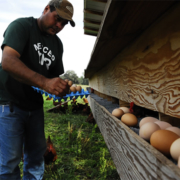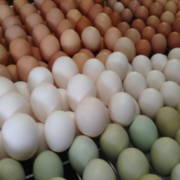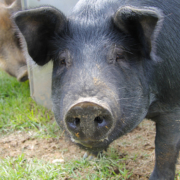Many Places for Pastured Poultry on This Integrated Farm
 Print This Post
Print This Post
By Ann Baier, Sustainable Agriculture Specialist
I had been looking forward to a visit to the Burroughs Family Farms with university extension and beginning farmers alike, to learn from this multigenerational farm family about how they integrate raising pastured laying hens with their certified organic farm enterprises. With a decade of experience with poultry, they are refining their practices by moving coops through their pastures and orchards to build soil health and fertility while producing nutrient-dense eggs. Every season brings new learning opportunities.
As excited as I was to visit, it was not to be. Based in Merced County, California, this family of experienced farmers has weathered many changes. When the pandemic prevented the farm’s in-person tours and poultry workshops, Rosie sprang to action. She went to the field with her phone and recorded interviews with three generations of her family. They have generously shared these videos to educate others.
Come along on this farm tour, in seven digestible videos, packed with practical information about what’s good for poultry, plants, people, and the land.
- Burroughs Family Farms Introduction
Rosie describes how she and her husband, Ward, manage the farm together with their children and grandchildren. Adding to generational and community wisdom, Rosie offers encouragement to new farmers, and describes their farming practices that are building soil health and cultivating resilience. - Daily Care of Pastured Poultry
Rosie’s grandson, Jed Bylsma, walks us through the daily care of laying hens on pasture. Choosing a productive breed, they collect eggs, keep production records, maintain feed and watering systems, and move mobile coops to fresh pasture. - Organic System Plan for Organic Certification of Laying Hens
Meridith Burroughs outlines the organic certification process, with audit trail records to identify inputs and track production, and how their organic system plan describes poultry housing, rations, and nutrition from foraging. Healthy living conditions, sunlight, fresh air, and outdoor access — required by USDA organic regulations — are abundant on Burroughs Family Farm. - Livestock Guardian Dogs for Poultry and Sheep
Livestock guardian dogs (LGDs) keep both livestock and predators safe by keeping them separate. Meridith emphasizes that effective LGDs are working dogs. They need not only natural instinct but also adequate training, which requires farmer time and patience. - Fencing for Poultry, Sheep and Cattle
Interior electric fencing is used for a short period to train poultry to use their coop as home base for roosting and laying. Livestock guardian dogs protect the area within perimeter barbed-wire fencing, so coop doors can remain open, allowing the birds to go out early in the morning. - Integrating Pastured Poultry with other Farm Enterprises: Dairy, Almonds and Olives
Ward Burroughs explains “stacking” integration of pastured poultry with other farm enterprises. Chickens follow cows through pastures. Smaller coops fit between tree rows, allowing hens to forage on winter cover crops grown to nourish and protect the soil in almond and olive orchards. - Mobile Henhouse Construction
Ward Burroughs describes construction of a mobile layer henhouse using the frame, chassis, and wheels of a retired cotton trailer. Designed for the hot Central Valley, each coop has a wide roof and shade cloth. Roll-out nest boxes keep the eggs clean, and facilitate gathering from the outside. Each henhouse houses 4,000 to 5,000 birds.
Related Resources:
Soil Health Principles – Application and Results of Investing in Your Soils
This blog is produced by the National Center for Appropriate Technology through the ATTRA Sustainable Agriculture program, under a cooperative agreement with USDA Rural Development. ATTRA.NCAT.ORG.












